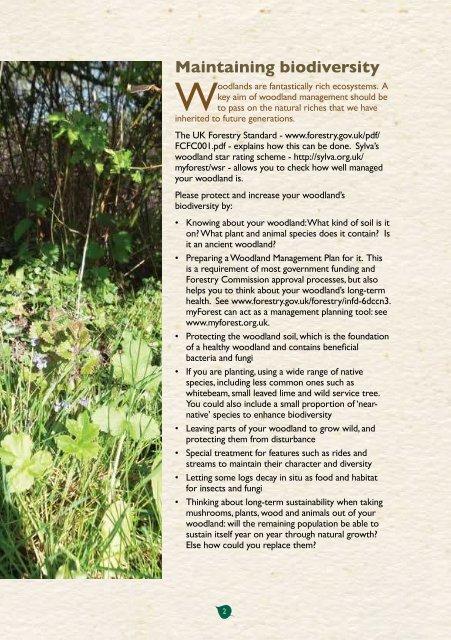Woodland-management
Woodland-management
Woodland-management
- No tags were found...
You also want an ePaper? Increase the reach of your titles
YUMPU automatically turns print PDFs into web optimized ePapers that Google loves.
Maintaining biodiversity<strong>Woodland</strong>s are fantastically rich ecosystems. Akey aim of woodland <strong>management</strong> should beto pass on the natural riches that we haveinherited to future generations.The UK Forestry Standard - www.forestry.gov.uk/pdf/FCFC001.pdf - explains how this can be done. Sylva’swoodland star rating scheme - http://sylva.org.uk/myforest/wsr - allows you to check how well managedyour woodland is.Please protect and increase your woodland’sbiodiversity by:• Knowing about your woodland: What kind of soil is iton? What plant and animal species does it contain? Isit an ancient woodland?• Preparing a <strong>Woodland</strong> Management Plan for it. Thisis a requirement of most government funding andForestry Commission approval processes, but alsohelps you to think about your woodland’s long-termhealth. See www.forestry.gov.uk/forestry/infd-6dccn3.myForest can act as a <strong>management</strong> planning tool: seewww.myforest.org.uk.• Protecting the woodland soil, which is the foundationof a healthy woodland and contains beneficialbacteria and fungi• If you are planting, using a wide range of nativespecies, including less common ones such aswhitebeam, small leaved lime and wild service tree.You could also include a small proportion of ‘nearnative’species to enhance biodiversity• Leaving parts of your woodland to grow wild, andprotecting them from disturbance• Special treatment for features such as rides andstreams to maintain their character and diversity• Letting some logs decay in situ as food and habitatfor insects and fungi• Thinking about long-term sustainability when takingmushrooms, plants, wood and animals out of yourwoodland: will the remaining population be able tosustain itself year on year through natural growth?Else how could you replace them?Safety and insuranceMany woodland activities carry an element of risk: swarming bees, boggy ponds,tree saw nicks that can bleed copiously, and of course chainsaws. <strong>Woodland</strong>burials (see later in this booklet) are lovely, but do avoid premature ones!• If carrying out risky activities, bring a first aid kit and mobile phone, and havesomebody else on site with you• If using a chainsaw, get (or require contractors to have) CS30/CS31 certificationand use personal protective equipment• Carry out a risk assessment before any potentially risky activity, and particularlybefore group activities (e.g. coppicing with volunteers)<strong>Woodland</strong> owners should have public liability insurance, even if the woodland isnot formally publicly accessible. The Occupiers’ Liability Act of 1957 states that theoccupier of a premise (in this case the woodland owner) owes a duty of care to bothlawful visitors and trespassers, and so may be liable for accidents that occur on theirpremises. You will definitely need insurance if you are a community group that ownsa woodland; or allow Forest Schools and other similar groups on your land. If youhave volunteers working in your woodland, you are strongly recommended to haveinsurance. Good value public liability insurance for woodland owners - £154 per yearin 2013/14 - is available from Rural Arbor Products, www.r-a-p.co.uk.Selling your productSelling your product is not always easy: in the early days, it can involve as much workas making the product. You may need to visit possible buyers, offer free samples ofyour products, offer to give talks about your woodland and its products etc. Howeveronce people know about you, then much less marketing work is required. Possibleoutlets for your products include:• fairs, fetes and woodland events suchas the Wychwood Forest Fair• farmer’s markets• selling direct to a local supplier• garden centres and local shops• allotment societies and gardeninggroups• small stand at the woodland gate• your own or other people’s websites.Further information:Forestry Commission Marketing Guide for Owners of Small <strong>Woodland</strong>s, www.forestry.gov.uk/england-woodmarketing.23


